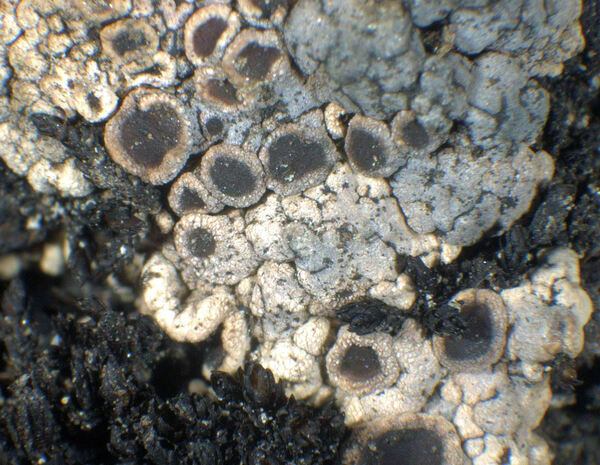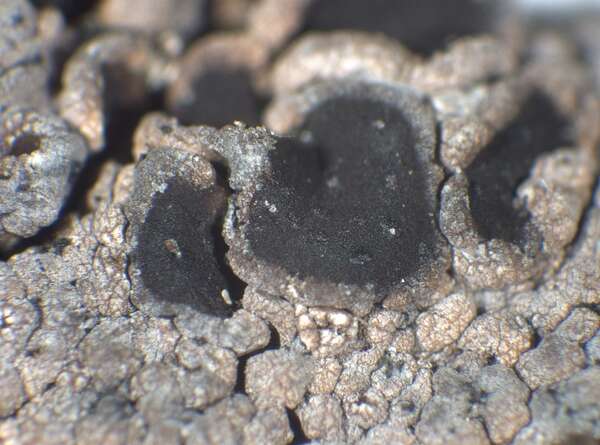Bryonora rhypariza (Nyl.) Poelt
Nova Hedwigia, 38: 97, 1983. Basionym: Lecanora rhypariza Nyl. - Öfvers. K. Svensk. Vetensk.-Akad. Förh.: 296, 1860.
Synonyms: Bryodina rhypariza (Nyl.) Hafellner & Türk
Distribution: N - TAA, Lomb, Piem (Isocrono & al. 2004, Isocrono & Piervittori 2008), VA (Piervittori & Isocrono 1999).
Description: Thallus crustose to subsquamulose, episubstratic, grey to brownish grey, more or less grey-pruinose, thick. Areoles/squamules 0.2-0.5(-1) mm broad, sometimes larger, contiguous, often forming an up to 4 cm wide, subrosulate crust, the surface finely rugose. Cortical cells greenish brown; medulla white. Apothecia clearly lecanorine, sessile, 0.5-2(-3.5) mm across, at first circular in outline, then frequently irregular-lobed, with a dark brown to blackish brown, mostly flat, epruinose disc, and a thick, crenulate, paler thalline margin. Thalline exciple 0.06-0.2 mm wide, with numerous granules; proper exciple poorly developed laterally; epithecium brown; hymenium colourless, 85-110 µm high, I+ blue; paraphyses simple, coherent, 1.5-2 µm thick at mid-level, the apical cells swollen, up to 5 µm wide, with a brown cap; lower part of hypothecium made up by strongly interwoven hyphae which separate it from the exciple, which extends below the hypothecium. Asci 8-spored, clavate, the K/I+ blue tholus penetrated by a faintly amyloid apical cushion with parallel or diverging flanks, the wall K/I-, surrounded by a K/I+ blue outer layer, Lecanora-type. Ascospores 1-celled (rarely 1-septate), hyaline, ellipsoid-cylindrical, sometimes slightly curved, thin-walled, (14-)16-23(-26) x 4-7 µm. Pycnidia dark, ovoid, immersed. Conidia bacilliform, 12-17 µm long. Photobiont chlorococcoid. Spot tests: thallus K+ yellow turning red (needle-like crystals), C-, KC-, P- or P+ pale yellow. Chemistry: norstictic and connorstictic acids.Note: a mainly arctic-alpine species found on mosses (Andreaea, Grimmia) near or above treeline, often associated with cyanobacteria (Stigonema); almost certainly restricted to the Alps in Italy.
Growth form: Crustose
Substrata: soil, terricolous mosses, and plant debris
Photobiont: green algae other than Trentepohlia
Reproductive strategy: mainly sexual
Commonnes-rarity: (info)
Alpine belt: rather rare
Subalpine belt: very rare
Oromediterranean belt: absent
Montane belt: absent
Submediterranean belt: absent
Padanian area: absent
Humid submediterranean belt: absent
Humid mediterranean belt: absent
Dry mediterranean belt: absent

Predictive model
Herbarium samples


P.L. Nimis CC BY-SA 4.0 [17240], Brazil. São Paulo. Praia de Peruibe near Itanhaém, in a dense mangrove forest on Laguncularia racemosa, 2 m, 24°10' S, 46°50' W. Leg. K. Kalb 24.02.1978 (Nr. 37602), det. K. Kalb. Dupl. ex Herbario Klaus Kalb.
GZU (54-93)
Growth form: Crustose
Substrata: soil, terricolous mosses, and plant debris
Photobiont: green algae other than Trentepohlia
Reproductive strategy: mainly sexual
Commonnes-rarity: (info)
Alpine belt: rather rare
Subalpine belt: very rare
Oromediterranean belt: absent
Montane belt: absent
Submediterranean belt: absent
Padanian area: absent
Humid submediterranean belt: absent
Humid mediterranean belt: absent
Dry mediterranean belt: absent

Predictive model
| Herbarium samples |


 DOLICHENS
DOLICHENS



